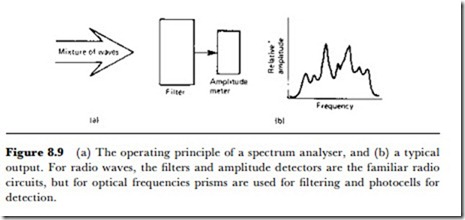Spectrum analysers
Spectrum analysis means obtaining information on the amplitude of waves for each frequency of waves in a set, the spectrum of the title. Originally, the phrase applied only to the visible spectrum, but developments in wave detection led to infrared and ultraviolet spectrum analysers being developed, and the title is now also applied to instruments that analyse the radio-frequency spectrum in a similar way. The principle of all types of spectrum analysers (Figure 8.9) is that each frequency in the spectrum is selected by a filter and its amplitude measured. The display of the informa- tion can be on a cathode ray tube, or as a graph or a printout from an attached computer.
For the radio-frequency spectrum, the filtering action is carried out by tuned circuits, using LC circuits for the lower frequencies and cavities for the microwave region. The range of frequencies requires any radio- frequency spectrum analyser to operate in switched bands, because no single tuning circuit can operate over more than a small part of the useable range. For the visible spectrum of light, the filtering action is obtained by using a glass prism, using the principle that the angle through which a light beam is bent will depend on the frequency of the light.
Infrared and ultraviolet spectrum analysers cannot make use of glass prisms apart from the small part of the spectrum that lies next to the visible range. Materials such as quartz for ultraviolet and rock salt for infrared can be used, and in the region where the longer-wave infrared meets the short-wave microwave range, prisms of paraffin wax are effective. The shorter the wavelength of the radiation, the more difficult it is to find a material for a prism, because the action of a prism depends on dispersion, meaning that the speed of the waves in a material depends on their frequency. The shorter the wavelength, the less is the interaction with the atoms of materials and the lower the dispersion. As we approach the X-ray frequencies, nothing is suitable as a prism and practically all materials are transparent.
Spectrum analysers in all classes are usually operated by electronic methods, and make use of electronic detection. For the radio-frequency ranges, the filters can be electrically controllable and the filtered frequencies detected by a diode, so that the plotting of received amplitude for each frequency can be controlled by a microprocessor. The higher frequencies, of which the visible range is at the higher end, are dealt with using a servo- motor to rotate the prism and a detector such as a photocell to measure the amplitude of the received signal.
